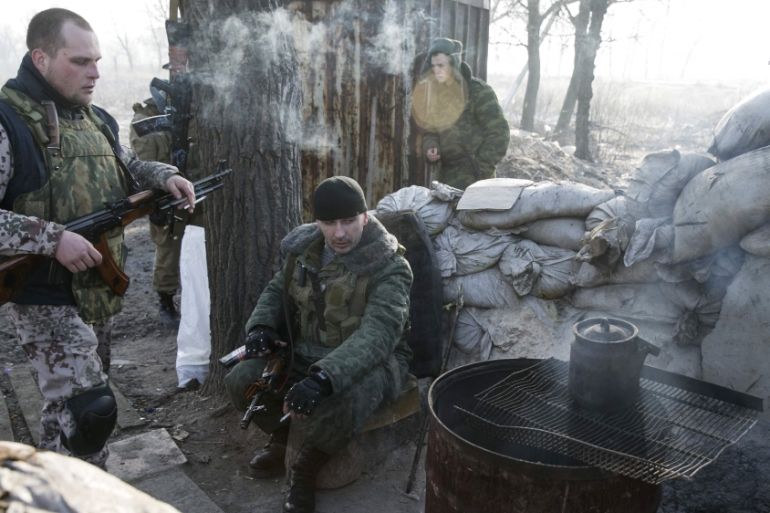The ceasefire in East Ukraine won’t last long
Only in the la la land of power politics can the fighting in Ukraine cease in a matter of days.

Before we come to the new ceasefire arrangement which was hammered out in an all-night marathon session in the Belarusian capital of Minsk, I would like to make a point about the failure of politicians venturing into the art of war. It happened in Iraq, Afghanistan, Georgia, Libya, Syria, and now it’s happening in Ukraine.
Ill-conceived military decisions were approved by people who have no idea about how wars are waged. This has led to disastrous consequences – huge numbers of people have died and many more have had to leave their homes and become eternal refugees.
The ceasefire arrangement for eastern Ukraine has been agreed to, but it has not been signed by any of the political leaders representing Ukraine, Russia, Germany, and France. The document has simply been passed over to the “contact group” including foreign ministers and representatives of the Organization for Security Co-operation in Europe. So, in practical terms, this means it is not yet official.
Stumbling block
The most significant stumbling block is that the parties have agreed to an unachievable plan that has no proper timetable for the cessation of hostilities. Only in the la la land of power politics can the fighting between government troops – assisted by renegade militias, with units of self-proclaimed republics and more stubborn renegade militias – cease in a matter of days.
|
|
Every self-respecting oligarch in Ukraine now has his own private army to back up his own narrow agenda, not to mention the similarly anarchic units among the rebels who pay no attention to what the “governments” in Donetsk and Luhansk say.
So even if, by some miracle, we see the cessation of hostilities in eastern Ukraine at some point this week, they are bound to resume very soon.
Just like the warring sides in Libya or Syria, there are too many different groups involved in the conflict in eastern Ukraine. When the parties in Minsk agreed to start disarming the militias on both sides, they were operating in a world of make-believe.
The biggest problem in the political resolution of the conflict in eastern Ukraine is the decision to put the matter of determining the status of the two breakaway regions of Donetsk and Luhansk on hold till the end of the year. In effect, the most important element of the crisis is being swept under the carpet “till better days”, creating the conditions for the ceasefire arrangement to fail.
Leaders will not wait
The leaders of the two breakaway regions will not wait until the Ukrainian government and parliament implement a constitutional reform by the end of 2015 that would envisage some sort of autonomy for Donetsk and Luhansk. It simply makes no sense. It’s a bit like telling ISIL to give the governments of Syria and Iraq time to work out a status for their caliphate in their respective constitutions.
If Angela Merkel and Francois Hollande were serious about this deal, they wouldn't have returned from Minsk and started threatening Russia with more sanctions if Moscow failed to stick to the arrangement.
Once this key provision failed to get recognition in the ceasefire arrangement, the whole thing collapsed.
If Angela Merkel and Francois Hollande were serious about this deal, they wouldn’t have returned from Minsk and started threatening Russia with more sanctions if Moscow failed to stick to the arrangement. How on earth can one side of the deal see to it that it sticks?
Also, there was the absence of the US at the all-night marathon session in Minsk and the pathetic assurances made by some parties that the process was conducted in the “Normandy format”, a set-up agreed in France during the celebrations of the 70th anniversary of the D-Day landing last year.
Who on earth is going to believe that a sustainable ceasefire agreement can be reached without Uncle Sam’s involvement, when Petro Poroshenko consults his “controllers” in Washington on a daily basis? When the Obama administration openly toys with the idea of sending heavy weaponry to the Ukrainian army practically daily?
Arms to Ukraine?
The cynical view among rebel leaders in eastern Ukraine is that the whole exercise has been pushed forward by Merkel and Hollande simply because they wanted to save Ukrainian President Poroshenko and his troops from suffering a heavy defeat around the strategically important town of Debaltseve.
According to the rebels, thousands of Ukrainian soldiers have been surrounded and are in danger of being wiped out there.
The Ukrainian government disputes that, but the mere fact that Merkel and Hollande suddenly responded to proposals Moscow had made last year and rushed to see Russian President Vladimir Putin speaks volumes.
So now the question is: Will the new ceasefire arrangement hold? Pretty much everyone agrees that it probably won’t, but they still believe it is better than nothing. My sources in Moscow tell me that Putin is philosophical about the new deal.
He thinks that if Merkel and Hollande were really serious, they would have agreed to resolve the status of the breakaway regions quickly, and would have given some sort of assurance that Ukraine would not be dragged into NATO under any pretext.
The NATO issue is crucial for Russia and all the noise from Kiev does not reassure Moscow in the slightest that the matter is put on hold.
Still, Putin can take comfort in the fact that not a word was mentioned in Minsk about the future of Crimea – one done deal that he can stick as a feather in his cap.
Alexander Nekrassov is a former Kremlin and government adviser.
The views expressed in this article are the author’s own and do not necessarily reflect Al Jazeera’s editorial policy.
